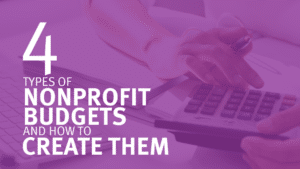
For nonprofits like yours, financial planning is critical for effective fundraising and development. Although fundraising allows you to bring in the revenue you need to further your mission, it’s your financial strategy that allows you to manage that revenue effectively, keep expenses in check, and plan for growth.
One of the most important tools for nonprofit financial planning is your budget. Jitasa’s nonprofit budgeting guide defines this resource as “a planning document used to predict expenses and allocate resources for your organization. It details both the costs that your organization will incur as well as the revenue you expect to receive over a set period of time.”
However, your budget isn’t limited to a general financial plan for the fiscal year. In this guide, we’ll explore four types of nonprofit budgets that will likely be useful in your organization’s fundraising and development efforts. Let’s dive in!
1. Annual Operating Budget
Your annual operating budget is the technical term for the master financial plan mentioned above, which governs all of your nonprofit’s financial activities for a given fiscal year. It’s divided into two main sections: projected revenue and expenses. Let’s look at each of these components in more detail.
Revenue
The revenue side of your annual operating budget lays out all of the funding your nonprofit expects to receive throughout the year. Most organizations categorize this side of their budget by revenue source. These sources often include:
- Individual donations. You’ll likely break this section down further based on donation type, such as major gifts, online donations, event revenue, and in-kind contributions.
- Corporate philanthropy. This category includes all of the ways in which for-profit businesses contribute to your nonprofit, including sponsorships, employer matching gifts, and volunteer grant programs.
- Earned income. While earned income often isn’t associated with nonprofits, it can be an essential part of your revenue generation strategy. For instance, you could create a membership program, rent out your facilities to other organizations for their events, or open an online store to sell branded merchandise.
- Grants. These funds are typically provided by foundations or governments to support a specific program or project at your nonprofit. To win them, you’ll need to submit a standout proposal to make the case to the grantmaker that your organization is worth investing in.
Expenses
While it’s often most useful to categorize revenue by source to keep your nonprofit’s fundraising on track, the most effective way to organize expenses is usually by function. This is because nonprofit tax returns require you to report on your functional expenses, so it’s helpful to keep all of your documents consistent for financial analysis purposes.
The three main categories of functional expenses are:
- Program costs, or the expenses necessary to run your nonprofit’s programs and make a difference in your community. These will vary depending on your mission.
- Administrative costs, which are associated with your organization’s operations. These include things like rent, utility bills, office equipment, and staff salaries.
- Fundraising costs, which are incurred while planning and launching campaigns. They include money spent on event planning, marketing, donation processing, and fundraising software. The combination of your administrative and fundraising costs makes up your nonprofit’s overhead.
A common misconception about operating budgets is that because nonprofits by definition can’t turn a profit, their budgets have to break even every year. However, if your organization can budget for a revenue surplus, you should! This way, you’re more likely to have enough funding to cover your expenses if some costs are higher than expected or a revenue source falls through. Then, you can use any leftover revenue to build your nonprofit’s reserve funds.
2. Capital Budget
The term “capital budget” might make you think of capital campaigns—the largest fundraising initiatives nonprofits typically run. And while capital campaigns are one type of project where a capital budget could be applicable, capital budgets can predict the revenue and expenses for any multi-year or long-term initiative at your organization.
Once your organization decides to launch a project that requires a capital budget, nail down the total amount of revenue you need to complete that project. This goal will guide the expense side of your budget, which should break down the direct and indirect costs associated with the initiative. These categories will likely be more narrow than the functional expenses in your operating budget, such as consulting fees, construction costs, or permits.
Then, plan how you’re going to raise the funds you’ll need on the revenue side of the budget. This includes determining how much revenue will come from small, mid-level, and major gifts, as well as whether you’ll use any existing funding toward the initiative. You should also create an initial timeline for the project so you can check in on your spending and fundraising as it progresses.
3. Program Budget
Program budgets are exactly what they sound like: they outline the revenue and expenses for one of the programs your nonprofit uses to further its mission. Some program budgets may last the entire duration of a temporary program, while budgets for ongoing programs are often re-evaluated at the start of each fiscal year so you can compare them to your organization’s operating budget.
For example, let’s say an education-focused nonprofit had an ongoing program that provided free tutoring for high school students. They’d likely want to create a new budget for each fiscal year to ensure the grant funding and individual donations that go toward the program are reflected in the organization’s program and operating budgets. Similarly, their expenses for supplies, classroom space, and marketing might fluctuate year to year, which the program budget should take into account.
4. Event Planning Budget
Although events are some of the most engaging nonprofit fundraisers out there, they require a variety of upfront expenses. Some of these include:
- The venue—either a physical space for an in-person event, a software platform for a virtual event, or both for a hybrid event.
- Entertainment, catering, and decorations to create a positive experience.
- Communication materials to market the event and follow up with attendees.
- Other event-specific needs, such as items to sell at a silent auction or snacks and water bottles for walk-a-thon participants.
It’s important to create a budget for each event you host—not only to account for these expenses, but also to allocate the revenue you’ll need to cover these costs. Evaluate what funding your nonprofit already has on hand, and make strategic decisions about how to fundraise effectively during the event. Additionally, Swaim Strategies’ guide to nonprofit event planning recommends outlining a detailed strategy for soliciting corporate sponsorships in your budget to help ensure you can cover all of your costs and hit your event fundraising goal.
As you begin creating any of these types of budgets, there are templates and resources available online to help you organize your nonprofit’s unique structure of revenue and expenses. However, the best way to ensure an effective budget is to work with a nonprofit accountant. They have the expertise not only to help you predict your revenue and allocate your expenses accurately, but also to identify areas where your organization can reduce costs and boost revenue generation for a more sustainable financial future.

Jon Osterburg has spent the last nine years helping more than 100 nonprofits around the world with their finances as a leader at Jitasa, an accounting firm that offers bookkeeping and accounting services to not for profit organizations.
